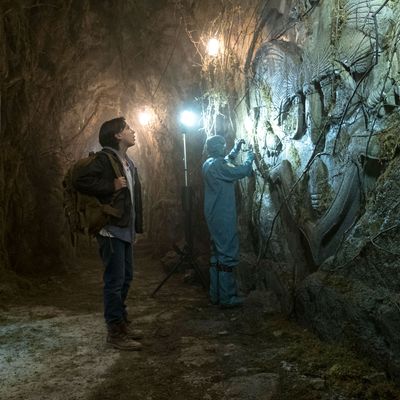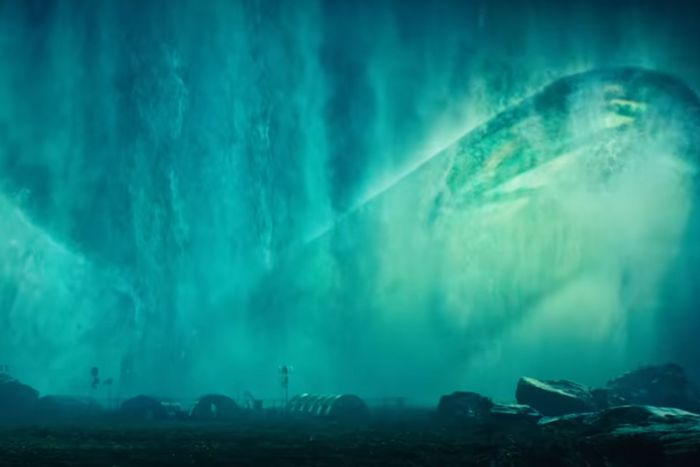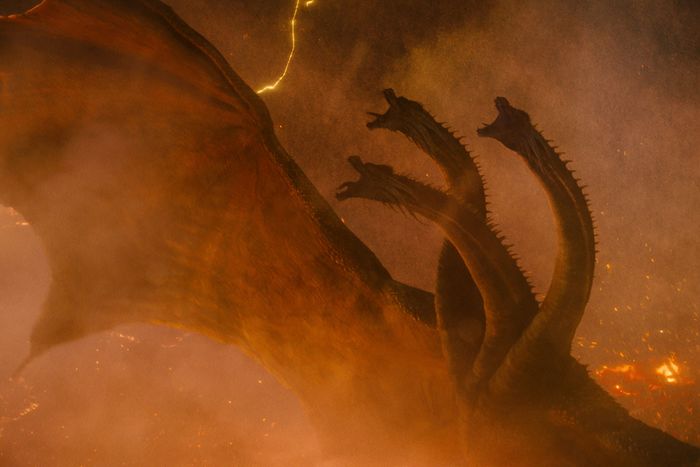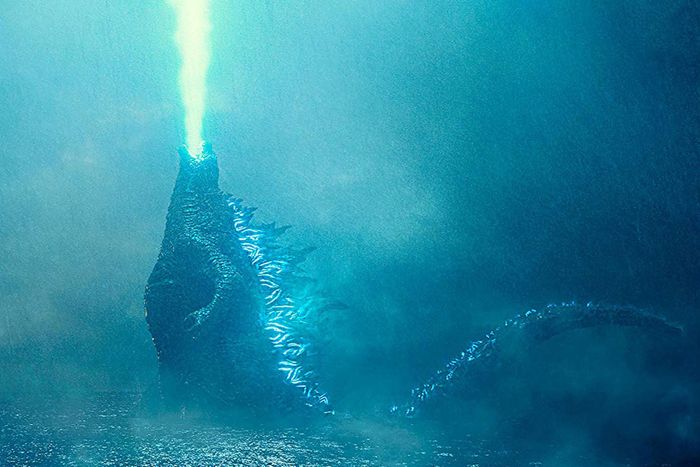
By the time Charles Dance walks back into frame in Godzilla: King of the Monsters’s post-credits scene, kaiju fans will no doubt have picked up on the plethora of Easter eggs and other nods to the longstanding lizard franchise sprinkled throughout the movie. But Dance’s final appearance as the villainous Alan Jonah provides the biggest hint of what’s next — a glimpse of a plot point that might drive the next MonsterVerse film. In those closing moments, we learn that one of King Ghidorah’s severed heads is still out there and Alan has plans for it.
What does the surviving head signify? People have theories. (Looking at you, Mecha-King Ghidorah fans.) But to understand the Mecha-Easter egg, you must first catch up on your foundational Monarch history. (If you don’t know what Monarch is, this might be tough.) The third film in Legendary’s MonsterVerse (joining 2014’s Godzilla and to 2017’s Kong: Skull Island) begins with an homage to 1964’s Ghidorah, the Three-Headed Monster (the movie that marked Ghidorah’s debut appearance in the Toho franchise and cemented Mothra’s and Rodan’s roles as classic Godzilla monsters) — so it’s best to start there. Here, our fittingly titan-size list of all of the Easter eggs that follow, ending with our best theories on what that post-credits scene means.
Mosura
Just as Monarch — the secret scientific organization dedicated to studying massive unidentified terrestrial organisms (MUTOs) around the world — designated Godzilla “Titanus Gojira” as a nod to the character’s original Japanese name, “Titus Mosura” is a nod to the giant moth Mothra’s original Japanese name.
Mothra’s Classic Egg Design
A brief glimpse of a screen in the Monarch base shows an image of Mothra’s egg that appears to look quite a bit like the yellow-and-blue encasement out of which the giant moth has hatched in earlier movies. In fact, the pastel-colored egg looks like a literal Easter egg.
Destroy All Monsters
A protester early in the film holds up a sign that says “Destroy All Monsters,” the name of a 1968 film that was basically The Avengers of Godzilla, as it featured 11 kaiju, many of which had never appeared in a proper Godzilla movie before.
Mind-Controlling Monsters
The Orca device — which is named after the whales but could just as easily be a little nod to the ship from Jaws, another classic monster movie — can control kaiju to a limited extent. The Godzilla franchise before King of the Monsters is full of various methods of controlling or communicating with giant monsters, ranging from various alien inventions to a squadron of psychics.
Mothra’s Theme Music
Composer Bear McCreary is responsible for King of the Monsters’s music, having taken over for Alexandre Desplat, who scored the 2014 movie. McCreary’s score features two classic themes from the original Japanese series, which he weaves into certain parts of his score. The first is Mothra’s theme song, which Yuji Koseki first composed for the kaiju’s 1962 debut and the legendary Godzilla composer Akira Ifukube perfected once the two monsters met in 1964’s Mothra vs. Godzilla.
King Kong Cameo
At several points throughout the movie, there are mentions of Skull Island and Kong, a reference to Kong: Skull Island, which is also part of the MonsterVerse. The next movie in the series is Godzilla vs. King Kong, so there’s probably a reason why King of the Monsters keeps reminding you that Kong is out there.
Scylla
Godzilla, Rodan, Mothra, and King Ghidorah are the only classic kaiju from the Japanese films to appear in King of the Monsters, as all the other Titans are original creations. That said, Scylla, a spider with some squidlike aspects, is fairly similar to Kumonga, a giant spider who first appeared in 1967’s Son of Godzilla. There’s another connection between the two: Scylla first appears in Arizona, and Kumonga attacks the state in 2004’s Godzilla: Final Wars.
Behemoth, Methuselah, and Other New Monsters
None of the other monsters in King of the Monsters even remotely resemble existing kaiju. Behemoth is a novel apelike woolly mammoth, and while there was initially some suspicion that the mountainlike Methuselah could be Anguirus, a popular Ankylosaurus kaiju, that did not appear to be the case upon viewing. Eventually, we do see another MUTOs in this MosnterVerse edition, indicating that Godzilla didn’t kill all of them in the 2014 movie.
Castle Bravo
Monarch’s underwater headquarters is called Castle Bravo, which is one of the film’s darkest Easter eggs. In real life, Castle Bravo was the name of the first U.S. thermonuclear-weapon test on the Bikini Atoll in 1954. A Japanese tuna-fishing vessel, the Daigo Fukuryū Maru (or “Lucky Dragon No. 5” in English), was caught in the fallout, and several of members of the 23-man crew experienced severe burns and radiation poisoning as a result. In the end, one crew member died. The incident served as direct inspiration for the original Godzilla, which opens with Godzilla sinking and irradiating a fishing ship.
Monster Zero
Ghidorah’s top-secret Monarch designation is “Monster Zero,” a nod to the second film in which the kaiju appeared, 1965’s Invasion of the Astro-Monster. In that film, aliens from Planet X “borrow” Godzilla and Rodan to defend them from Ghidorah, who they call Monster Zero. It was a trick, though, as Ghidorah was under the aliens’ control the whole time. The aliens make all three kaiju attack Earth, but they’re eventually defeated.
Maser Turrets
The weapons on Castle Bravo are labeled “Maser Turrets,” an allusion to a mostly fictional laser-ray weapon humans used to fight kaiju throughout many of the previous Japanese Godzilla films.
Dr. Brooks’s Hollow Earth Theory
Bradley Whitford’s character, Dr. Rick Stanton, mentions “Dr. Brooks’s Hollow Earth theory,” a reference to Dr. Houston Brooks, the character Corey Hawkins played in Kong: Skull Island. We actually see Dr. Brooks later in King of the Monsters, when Mothra emerges from her coccoon, this time played by Joe Morton.
Godzilla’s Theme Music
When Godzilla emerges from beneath the ice to do battle with King Ghidorah in Antarctica, the second of the two classic Godzilla music cues plays. Akira Ifukube originally composed the song for 1954’s Godzilla, and while at the time it was meant to be associated with the heroic Japanese Self-Defense Force trying to defeat Godzilla, it quickly became “Godzilla’s Theme.” King of the Monsters marks the first time that it has been heard in an American Godzilla film.
Rodan’s Volcano Lair
Rodan emerges from a Volcano, a nod to the kaiju’s first appearance in 1956, when two Rodans hatched from eggs that were buried near Mount Aso, Japan’s largest active Volcano. Ultimately, the military defeats the two monsters by tricking them into flying into the volcano’s eruption, where they seemingly perish. One of them does reemerge from the Volcano in Ghidorah, the Three-Headed Monster.
Fire Rodan
In 1993’s Godzilla vs. Mechagodzilla II, Rodan is powered up by atomic energy and becomes Fire Rodan. Legendary’s version of the kaiju doesn’t have that monster’s radioactive-breath powers, but it does seem to draw influences from Rodan’s volcanic origins and fiery nature.
Oxygen Destroyer
During their second fight, the military unleashes a powerful new weapon called the Oxygen Destroyer in an attempt to defeat Godzilla and King Ghidorah. It doesn’t work, but the name should bring chills to any longtime Godzilla fan. In the first movie, the Oxygen Destroyer was the name of a horribly powerful weapon invented by Dr. Daisuke Serizawa (whom Ken Watanabe’s Ishiro Serizawa is named after). The weapon killed Godzilla when nothing else could, but Serizawa was so upset about his creation, and so worried that it might be used for greater destruction, that he let himself die while deploying it. That way, it could never be used again. It was all very grave and solemn, kind of a sharp contrast to the casual way it was deployed in King of the Monsters.
Ghidorah Loses a Head
Before the Oxygen Destroyer breaks up the fight, Godzilla is able to sever one of Ghidorah’s three heads. Godzilla also decapitates Ghidorah in 1991’s Godzilla vs. King Ghidorah, but in that instance he severed the kaiju’s middle head. Ghidorah was resurrected as Mecha-King Ghidorah in that film, whereas in King of the Monsters Ghidorah simply regenerates the missing head. However, the post-credits scene suggests a similar cybernetic fate might be in store …
The Twins, Dr. Ilene Chen and Dr. Ling
When Mothra emerges from her cocoon, we learn that Zhang Ziyi’s character, Dr. Ilene Chen, has a twin sister, Dr. Ling, who watches when Mothra spreads her wings. Twins are a big deal in the Mothra mythos, as the kaiju has traditionally been accompanied by the Shobijin, two tiny twin fairies who speak for her. It doesn’t seem like Dr. Chen is meant to be a fairy, but the fact that she and her sister are the latest in a line of three generations of twins who have a deep connection to Mothra is a pretty big Easter egg.
Infant Island
One of the pictures we see of Dr. Chen’s family lists their location as “Infant Island,” where Mothra and the Shobijin lived in their first appearance in 1961.
A Sunken City
After taking a submarine into the depths of the ocean with the hope of strengthening Godzilla with a nuclear explosion (itself a plot point that occurred in 1991’s Godzilla vs. King Ghidorah), our heroes find themselves in an ancient sunken city that Godzilla calls home. Underwater civilizations have appeared in Toho movies before, like in 1963’s Atragon, which involves the Atlantis-like lost continent of Mu, and 1973’s Godzilla vs. Megalon, the goofiest movie in the whole franchise, which features villains from “Seatopia.”
Serizawa’s Sacrifice
Echoing the ending of the original film, Dr. Serizawa sacrifices himself, though the circumstances couldn’t be more different. Godzilla’s Daisuke Serizawa kills himself to defeat Godzilla and prevent his powerful weapon from ever being used, while King of the Monsters’s Ishiro Serizawa dies saving Godzilla, using a powerful weapon to make him stronger.
Serizawa’s Stopped Watch
Before he dies, Serizawa looks at his stopped pocket watch, which we know from the 2014 Godzilla survived the atomic bombing of Hiroshima. Kinda weird that an icon of the horror of nuclear weapons is looked at fondly while another bomb blowing up saves the day, but whatever!
“Let Them Fight”
After Serizawa’s death, Dr. Sam Coleman (Thomas Middleditch), says his iconic and much-memed line from the 2014 movie, a little wink at how popular “Let Them Fight” became in the real world.
Godzilla’s Meltdown
After Serizawa’s nuke fires him up, Godzilla is just bursting with radioactive energy — maybe too much energy, actually. Godzilla is headed toward a thermonuclear explosion, and he starts glowing red. Longtime Godzilla fans will recognize “Burning Godzilla,” a version of the kaiju that appeared in 1995’s Godzilla vs. Destoroyah. Godzilla was headed toward a meltdown in that movie, and while it made him super-powerful, it also probably would’ve rendered the world uninhabitable had Godzilla been allowed to blow. The risk of nuclear death is downplayed in King of the Monsters.
Mothra’s Sacrifice
Mothra has allied herself with Godzilla several times in the history of the franchise (when Godzilla is a good guy, that is. When he’s evil, Mothra typically opposes him). The same holds true in King of the Monsters, where Mothra ultimately sacrifices herself to give Godzilla her power.
Similar things have happened in past movies, but not quite like this. In 2001’s Godzilla, Mothra, and King Ghidorah: Giant Monsters All-Out Attack, Mothra gives up her life force to power up not Godzilla but Ghidorah. In an unusual twist, Ghidorah was a good guy in this movie, while Godzilla was evil. In 1993’s Godzilla vs. Mechagodzilla II, Rodan sacrifices itself to give Godzilla the power to defeat Mechagodzilla. So, What happens in King of the Monsters is a fun remix of things we’ve seen before.
The King of the Jungle
Right after Dr. Emma Russell (Vera Farmiga) says, “Long live the king,” there’s a very brief shot of Godzilla stepping on an entrance to Boston’s Franklin Park Zoo. There’s a picture of a lion on the gatehouse, the implication being that the King of the Monsters is way tougher than the King of the Jungle. Take that, Disney’s Lion King remake.
Rodan Heads to Japan
The end credits are full of little hints of what’s next for the MonsterVerse, as well as possible allusions to Godzilla history. One news headline that flashes on the screen reveals that Rodan has taken up residence in a volcano near Mount Fuji. This brings Rodan back home to where he first appeared, though Mount Aso is on a totally different island than Fuji.
Mothra Reborn?
There’s mention of another Mothra egg, suggesting that Mothra will be reborn. This happens quite a bit in the movies.
Manda (But Probably Not)
Some Godzilla fans think there’s a reference to Manda, a Chinese dragonlike kaiju who first appeared in 1963’s Atragon, later making minor appearances in 1968’s Destroy All Monsters and 2004’s Godzilla: Final Wars. It’s a stretch, given that Manda is a very minor kaiju, and the serpentlike creature we see the briefest glimpse of could be anything. It almost certainly isn’t actually Manda, since Legendary would’ve needed to get the official rights from Toho.
Everyone’s Going to Skull Island
Some headlines reveal that there’s a mass kaiju migration toward Skull Island, where Kong lives. If Kong is another “Alpha” kaiju, like Godzilla and King Ghidorah, this might be what sparks the two titans’ battle in next year’s Godzilla vs. King Kong.
Steve Martin
One of the bylines on a news article reads “Steve Martin,” but it’s not Steve Martin the comedy legend. Instead, it’s a very subtle reference to the character Raymond Burr played in the American reedit of the original Godzilla, which was also subtitled King of the Monsters. Burr played an American journalist who was visiting Tokyo when Godzilla attacked, and he reprised the role in the American reedit of Godzilla Returns, which was titled Godzilla 1985 in the U.S. In that movie, though, the character was only ever referred to as “Steve” or “Mr. Martin,” because by that time, Steve Martin the comedian had become quite famous.
Blue Öyster Cult’s “Godzilla”
The end credits are set to cover of Blue Öyster Cult’s 1997 song “Godzilla,” which isn’t at all that subtle, but it does rock.
“Godzilla as Himself”
The end credits cheekily note that the four main monsters were all played by “themselves.” This is kinda funny, because kaiju in the Japanese films were famously played by men or women wearing suits, while King of the Monsters’s beasts were CGI. However, even in this movie, the monsters were technically played by people. Three different actors provided the motion-capture for King Ghidorah’s three heads, for instance.
In Memoriam
The credits actually include a touching remembrance of Haruo Nakajima, the actor who played Godzilla in the original 1954 film and 11 subsequent movies. Nakajima died in 2017. There’s also an “In Memoriam” to Yoshimitsu Banno, who also died in 2017 and directed and co-wrote 1971’s Godzilla vs. Hedorah, one of the most bizarre Godzilla movies, which went on to become a cult classic. Banno was a co–executive producer on Legendary’s 2014 Godzilla.
Post-credits Scene
The post-credits scene returns to Isla de Mara, where Rodan emerged from a volcano and Godzilla and King Ghidorah had their second battle. Alan Jonah (Charles Dance) appears and agrees to buy the severed King Ghidorah head that Godzilla ripped off during their earlier encounter.
Clearly, this is a setup for the next movie, but what kind of setup? Some Godzilla fans speculate that he’ll build some sort of Mecha-King Ghidorah, as seen in the 1991 movie. He would have to build a lot more cybernetic parts, though, as Mecha-King Ghidorah had a robotic replacement head, not a whole body.
Other theories suggest that the lingering effects of the Oxygen Destroyer might come into play, as the weapon’s after-effects created Destroyah in 1995’s Godzilla vs. Destroyah. The most intriguing possibility, though, is that the severed head will be used to create Bagan, a kaiju who was almost the villain in a bunch of different Godzilla or Mothra movies but ultimately ended up on the cutting-room floor. Bagan’s only major appearance was as the final boss of the SNES video game Super Godzilla, where he appeared as an ancient Chinese monster that had been strengthened by the alien infusion of Godzilla and King Ghidorah’s cells. Hmm …





